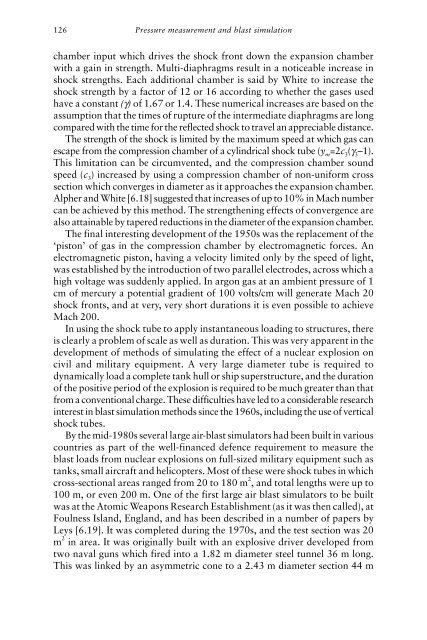A History of Research and a Review of Recent Developments
A History of Research and a Review of Recent Developments
A History of Research and a Review of Recent Developments
Create successful ePaper yourself
Turn your PDF publications into a flip-book with our unique Google optimized e-Paper software.
126<br />
Pressure measurement <strong>and</strong> blast simulation<br />
chamber input which drives the shock front down the expansion chamber<br />
with a gain in strength. Multi-diaphragms result in a noticeable increase in<br />
shock strengths. Each additional chamber is said by White to increase the<br />
shock strength by a factor <strong>of</strong> 12 or 16 according to whether the gases used<br />
have a constant (γ) <strong>of</strong> 1.67 or 1.4. These numerical increases are based on the<br />
assumption that the times <strong>of</strong> rupture <strong>of</strong> the intermediate diaphragms are long<br />
compared with the time for the reflected shock to travel an appreciable distance.<br />
The strength <strong>of</strong> the shock is limited by the maximum speed at which gas can<br />
escape from the compression chamber <strong>of</strong> a cylindrical shock tube (y m=2c 3(γ 3–1).<br />
This limitation can be circumvented, <strong>and</strong> the compression chamber sound<br />
speed (c 3) increased by using a compression chamber <strong>of</strong> non-uniform cross<br />
section which converges in diameter as it approaches the expansion chamber.<br />
Alpher <strong>and</strong> White [6.18] suggested that increases <strong>of</strong> up to 10% in Mach number<br />
can be achieved by this method. The strengthening effects <strong>of</strong> convergence are<br />
also attainable by tapered reductions in the diameter <strong>of</strong> the expansion chamber.<br />
The final interesting development <strong>of</strong> the 1950s was the replacement <strong>of</strong> the<br />
‘piston’ <strong>of</strong> gas in the compression chamber by electromagnetic forces. An<br />
electromagnetic piston, having a velocity limited only by the speed <strong>of</strong> light,<br />
was established by the introduction <strong>of</strong> two parallel electrodes, across which a<br />
high voltage was suddenly applied. In argon gas at an ambient pressure <strong>of</strong> 1<br />
cm <strong>of</strong> mercury a potential gradient <strong>of</strong> 100 volts/cm will generate Mach 20<br />
shock fronts, <strong>and</strong> at very, very short durations it is even possible to achieve<br />
Mach 200.<br />
In using the shock tube to apply instantaneous loading to structures, there<br />
is clearly a problem <strong>of</strong> scale as well as duration. This was very apparent in the<br />
development <strong>of</strong> methods <strong>of</strong> simulating the effect <strong>of</strong> a nuclear explosion on<br />
civil <strong>and</strong> military equipment. A very large diameter tube is required to<br />
dynamically load a complete tank hull or ship superstructure, <strong>and</strong> the duration<br />
<strong>of</strong> the positive period <strong>of</strong> the explosion is required to be much greater than that<br />
from a conventional charge. These difficulties have led to a considerable research<br />
interest in blast simulation methods since the 1960s, including the use <strong>of</strong> vertical<br />
shock tubes.<br />
By the mid-1980s several large air-blast simulators had been built in various<br />
countries as part <strong>of</strong> the well-financed defence requirement to measure the<br />
blast loads from nuclear explosions on full-sized military equipment such as<br />
tanks, small aircraft <strong>and</strong> helicopters. Most <strong>of</strong> these were shock tubes in which<br />
cross-sectional areas ranged from 20 to 180 m 2 , <strong>and</strong> total lengths were up to<br />
100 m, or even 200 m. One <strong>of</strong> the first large air blast simulators to be built<br />
was at the Atomic Weapons <strong>Research</strong> Establishment (as it was then called), at<br />
Foulness Isl<strong>and</strong>, Engl<strong>and</strong>, <strong>and</strong> has been described in a number <strong>of</strong> papers by<br />
Leys [6.19]. It was completed during the 1970s, <strong>and</strong> the test section was 20<br />
m 2 in area. It was originally built with an explosive driver developed from<br />
two naval guns which fired into a 1.82 m diameter steel tunnel 36 m long.<br />
This was linked by an asymmetric cone to a 2.43 m diameter section 44 m


